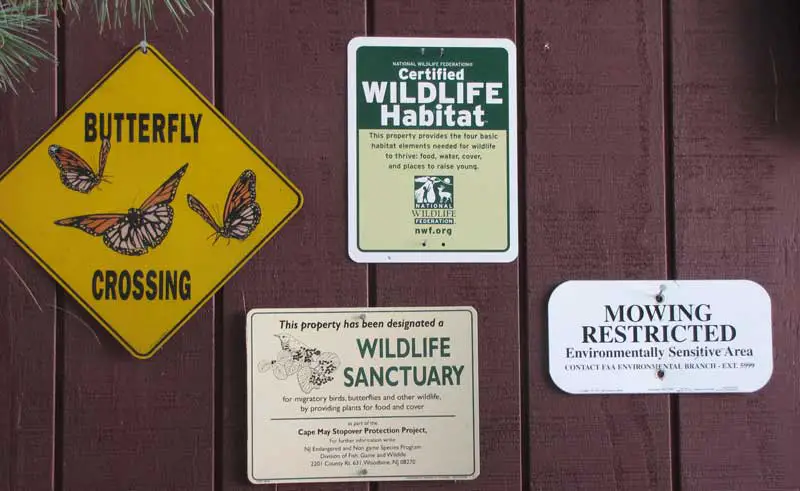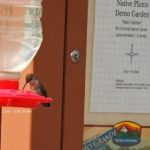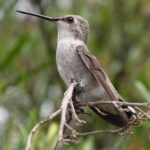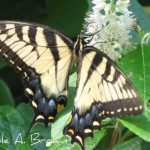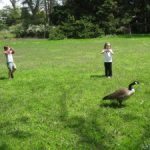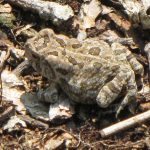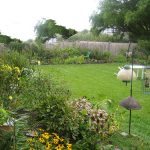On April 7, 2003, my garden became garden #35038 to become a Certified Backyard Wildlife Habitat by the National Wildlife Federation. Now there are over 100,000 certified wildlife habitat gardens, with more being added every day.
What does Certified Backyard Wildlife Habitat Mean?
For the purposes of the National Wildlife Federation, these were the key elements in a backyard wildlife habitat when my garden was certified:
- Food
- Water
- Shelter
- Safe places to raise young
It used to be that you could install several birdfeeders, put in a birdbath, and slap up some nest boxes and call your “habitat” done. Your garden could be certified on the basis of that alone.
It also used to be that having a “certified wildlife habitat” sign hanging in your garden was a type of status symbol for some gardeners. They had the sign, so they did not have to do anything else.
Disappointment and Disillusionment
It has been my strong feeling since going through the process of certification that there had to be more:
- What did the birds eat if we weren’t there to fill the feeders?
- How could we recreate or mimic elements of natural ecosystems in our gardens that would provide for the needs of not just birds but butterflies, pollinators, amphibians and other wildlife as well?
- Could we make better choices to benefit wildlife by reducing our use of fossil fuels, pesticides, herbicides, and chemical fertilizers?
- How could we responsibly manage stormwater and garden waste?
- What if we created welcoming habitats for wildlife on our whole properties, not just the backyard?
It has been my mission for almost 20 years to answer those deeper questions and to share those answers with you, whether as a garden consultant or here on these pages. Answering these questions and more is what led me to the concept of Ecosystem Gardening.
Because I was working so hard to provide better information for homeowners to make more responsible choices for wildlife in all aspects of property management, I became disillusioned and disappointed in the National Wildlife Federation’s approach. It seemed they were providing very minimal, basic information for wildlife gardening, while using the status of “the sign” merely as a fundraiser for their other projects.
This disappointment was so profound that I have not even looked closely at their website for several years. I felt that they were doing a large disservice to the many people who were looking to them to provide good information, by focusing solely on the acquisition of the sign for their fundraising purposes.
The New Certified Wildlife Habitat Program at NWF
In the past several weeks I’ve been looking again at the information included at the National Wildlife Federation’s Certified Wildlife Habitat program.
I have to say, I am liking what I see!
Here are the new elements of a wildlife habitat garden:
- Provide food for wildlife–Everyone needs to eat! Planting native forbs, shrubs and trees is the easiest way to provide the foliage, nectar, pollen, berries, seeds and nuts that many species of wildlife require to survive and thrive. You can also incorporate supplemental feeders and food sources.
- Provide water for wildlife–Wildlife need clean water sources for many purposes, including drinking, bathing and reproduction. Water sources may include natural features such as ponds, lakes, rivers, springs, oceans and wetlands; or human-made features such as bird baths, puddling areas for butterflies, installed ponds or rain gardens.
- Create cover for wildlife–Wildlife require places to hide in order to feel safe from people, predators and inclement weather. Use things like native vegetation, shrubs, thickets and brush piles or even dead trees.
- Give wildlife a place to raise their young–Wildlife need a sheltered place to raise their offspring. Many places for cover can double as locations where wildlife can raise young, from wildflower meadows and bushes where many butterflies and moths lay their eggs, or caves where bats roost and form colonies.
- Let your garden go green–How you maintain your garden or landscape can have an important effect on the health of the soil, air, water and habitat for native wildlife–as well as the human community nearby. Reducing chemical use, composting, mulching and reducing turf grass in your yard are important steps to gardening greener.
- All of this information and more can be found at the Create a Certified Wildlife Habitat page.
There’s a wealth of wonderful information to check out there. Make sure to spend some time perusing all of the pages.
More From Ecosystem Gardening:
Submit your review | |

